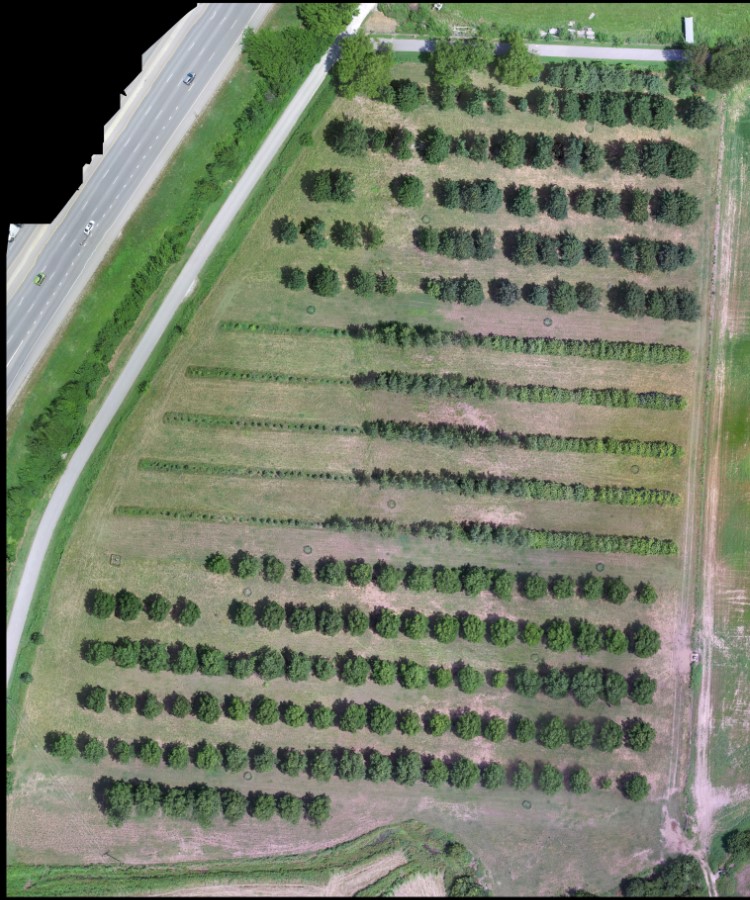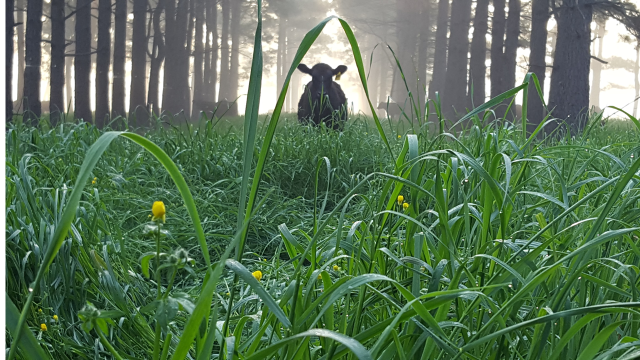This is at least a start. The big takehome is that you want to encourage native plants as your pasture forage. Microbial preference likely contributed to their self selection as native forage.
This field shows us a likely layout for a working silvopasture. essentially it shows us a missing row from an orchard configuration. This suggersts that it works well enough but the field looks like it got grazed far too tight.
Proper rotational grazing keeps a deep cover of ample broken grass which feeds the earth worms. Those same earthworms likely reduce dying root material as well.
Even with this spacing, that same field should support no till cropping and that is our likely future with all those bare fields.
What drives roots’ decomposition and carbon storage in grassland soils?
https://soilsmatter.wordpress.com/2021/11/01/what-drives-roots-decomposition-and-carbon-storage-in-grassland-soils/
You most likely know that roots are important for grasses to grow, but the roots help do other things, too. They build soil carbon and support other life forms in soil. But did you know that various management tactics can force grass roots to break down, decompose, and add to the stored carbon pool in soil?
As plant roots die off and decompose, nutrients and carbon are released to soils. The same is true for grasses. The dead roots also become part of the important organic matter in soil. Microbes that live in the soil use this as food for energy and form organic matter.
Decomposition of roots is a major source of soil carbon and important aspects of ecosystem function.
The driving factors behind root decomposition and how fast the process happens are largely unknown. My team’s work with the United States Department of Agriculture, Agricultural Research Service is studying this important topic especially in silvopastoral systems. Silvopasture is the intentional combination of agroforestry and animals. This can be either through grazing or hay management. An added benefit of silvopasture systems is that they can minimize economic risk to growers by providing different income streams.
Aerial image from a drone of the 17-year-old silvopastoral site with trees (oak, pine, cottonwood, sycamore, and pecans) and alleys (native grass mix and orchardgrass). Credit: Taylor Adams, USDA-ARS.
To improve the current understanding of root turnover in silvopastures, we evaluated:
decomposition rate differences between forage species (native and non-native);
fertility (poultry litter and a control), soil moisture (wet and dry); and,
grazing management (grazed and an un-grazed control).
We used the “litter bag” technique to answer these above research questions. We dug up live roots and weighed them. Then we dried the roots and placed the dry roots in breathable nylon bags. The nylon bags allowed water, oxygen, and soil microbes in. We then buried the dried root bags at specific depths near their original location.
We collected bags in batches: 20, 34, and 48 days after burying. On the day of each root bag retrieval, we cleaned the nylon bags, and then dried, weighed, and ground the remaining roots. We analyzed these roots for chemical and physical traits. We used imaging software to scan roots before they were buried, which helped us evaluate root architecture differences to determine how – and if – that is linked to root decomposition and carbon storage in soils.
Our team also collected soil near the experiment’s “bury site” to analyze for organic carbon content and organic matter.
Freshly dug and cleaned native grass roots, prior to placement in litter bags at a silvopastoral site in Fayetteville, AR. They were scanned to determine root surface area, root volume, and ratio of dry mass roots to volume prior to the drying process. Credit: Dr. Amanda Ashworth, USDA-ARS.
From the data we collected, we were able to determine decay rates based on management. We knew how much we had buried in the original nylon bags – and we know how much was left at 20, 34 and 48 days. This helped us calculate how quickly the soil microbes consumed roots and turned them into stored carbon.
Overall, our study found that there was greater root decomposition with native grass species and poultry litter applications, along with cattle grazing over time. Soil moisture affected root decomposition rates to a lesser extent. Greater decomposition under cattle grazing and poultry litter applications was likely due to added nutrients spurring microbial activity. In parallel studies, we evaluated carbon dioxide loss and soil microbial diversity in this area. Results from these studies support our root decomposition findings. They also found greater microbial diversity and carbon loss to the air, which suggests greater below ground activities under native grasses fertilized with nutrient-dense poultry litter.
We also found that native grass roots had more favorable food sources for microbes and overall composition, relative to the non-native forage in this study. With more food sources, there was greater root decomposition and ultimately greater soil organic carbon and organic matter storage. Soils under native grass roots had approximately 14% greater carbon than the non-native forage, which corresponded to an 11% greater root decay for native prairie grasses. These results suggest that the decomposition of native grass roots may be the source of more soil carbon.
A cow grazing in a silvopasture. Credit: Erin Wood, USDA-ARS
When we scanned roots with imaging software, we found that native grasses had greater root surface area, root volume, and ratio of dry mass roots to volume, relative to the non-native, cool-season forage. This could be related to native grass roots decomposing more quickly. Poultry litter applications also increased the ratio of dry mass roots to volume.
The take-home message of this study is that native prairie grass roots have a greater potential for root decomposition and overall soil organic carbon storage, relative to non-native forages. Nutrient-rich poultry litter applications also improve the carbon cycling and turnover in integrated silvopasture systems.
Our findings contribute to the current understanding of complex interactions of grass species, soil moisture, soil fertility, animal manure inputs, and grazing pressure. This can be useful in developing strategies for enhancing grassland productivity, as well as nutrient cycling and carbon sequestration in silvopastoral systems.
Answered by Amanda Ashworth, United States Department of Agriculture, Agricultural Research Service
Dr. Ashworth’s research was published in published in Agrosystems, Geosciences & Environment Journal.
Do you want to try a summertime soil microbe project at home? Take a clean, white t-shirt and cut it up into equal squares. Dig small holes in your yard in different locations, but at the same depth – and your compost pile, too! Be sure to mark their hiding spot. Dig up the squares in about a month and see what happens to them! Bury what remains in the same spot and dig up in another month.



No comments:
Post a Comment